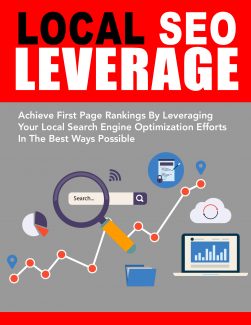 License Type: Master Resell Rights
License Type: Master Resell Rights  File Type: ZIP
File Type: ZIP
 SKU: 62311
SKU: 62311  Shipping: Online Download
Shipping: Online Download
Sample Content Preview
Search Engine Optimization (SEO) isn’t all about keywords.
It isn’t only about long-tail headers and meta-tags. In fact, a lot of search engine spiders ignore meta-data anyway.
Assearch engines continue to evolve, they are looking more and moreat format and layout.
This coursewill discuss a few things that you need to be aware of.
During the process of going through this course, be sure to check your website to make sure thatyou aren’t overdoing or underdoing any of these steps, and your search engine ranking should increase.
While this certainly shouldn’t be taken as an end all and be all resource or course on the concept of local SEO, it would help if you go in with an open mind and a fresh slate.
Because SEO is always changing, it’s important to remember that advertising and search engine optimization work the same as the real world.
The following is just a baseline that will help you brief yourself and get fully up-to-date on the topic of local SEO and such.
Take a good look at your page. Now go find a four-year-old and have them take a look. When you log into your website, you might already know where everything is, but if you have left it in the hands of your IT guy, that might work to your advantage inthis case.
• Is your siteeasy to navigate?
• Is it visually appealing without appearing cheap or overly gimmicky?
Believe it or not, web crawlers are starting to look at page layout and ease of navigation among other things. They will see if your internal links are easy to read, and they will compare the information from following those links to make certain that accuracyand consistency is maintained.
Search engines care about the user experience, after all, and they want to get their regular customers to the right information quickly.
The days of java buttons and cute pictures are gone.
If you have buttons that appear on the site as images, make sure that they are tagged in the HTML with exactlywhat is written on the button. You may have noticed this on other sites. You mouse over a button that says, “Home,” and a caption near your pointer reads “Home.”
Web spiders aren’t looking at your page visually, they are analyzing it through code, so if a button isn’t tagged, they never load the picture to decode the information presented. They simply see it as a picture and a link. That’s bad.
Generally speaking, text is best. With CSS and font embedding available, there is rarely a need for an image link (and if youhave one, then it needs a caption encoded with it).
The next thing you want to look at is easy navigation. Look again at your landing page. Pretend thatyou are your average customer.
Why did you come to this site?
If you run a flower business, then your customer probably showed up to buy flowers, not to read about the history of how it’s beenhanded down from your grandpa. If the order form or catalog isn’t the very first thing they see, then a link to it should be the first underlined text they come across.
Everything else should be in the menu, or in the sidebar, or at the bottom of the page. But the middle of your screen is the prime real estate. You viewers are typically there for one thing, put it right in front of them.
Your NAP information(Name, Address, and Phone number) should be readily availableas well.
Typically, this information is either found on a side-bar, or down at the bottom. This way it’s displayed on every page of the site, and the user (and consequently, the web spider) doesn’t have to go hunting for it by clicking every option on your menu or anything.
It should be on every, single, page; and it should appear identically.
If you do have an “about us” page where it is listed as part of the content, that’s fine. Two to three total impressions are the max, not because you should spam your address all over the place, but because you might have a map page, or a how to find us, or something similar.
You want this information to be tight and easy to read. No fancy fonts, make it large enough to see.
The one thing that is incredibly important is that the information appears the same, everywhere it is listed. Check every instance of this online business card to make sure they match, and search engines will treat you favorably.
If you have a transposed number in your zip-code, or a different formatting for your telephone number, it will be frowned upon. Remember, spiders aren’t people, they’re programs, and as much as they are attempting to emulate a user experience, they aren’t actually loading content, or seeing the page as your human customers do.
To plan for the future, all text on your site should be spoken in the language of human speech.
The sound and feel of every little blurb should sound as you would if you were speaking directly to your customers.
This is where overuse of keywords will become obvious, and a natural language approach will be better for voice searches and navigation, which are becoming more popular all the time.








